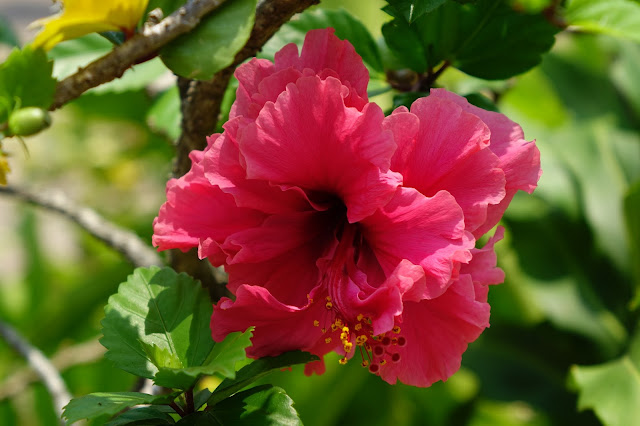Your idea of a wild time in the Caribbean might be endless
buckets of beer by the sea.
But there’s another wild side to the Caribbean—and you’ll
want to take your camera for this one.
Look out for this fauna and flora to
fawn over when you get back home:
The fauna for ya
Iguanas—They’re
everywhere. All over the rocks at Crown Bay pier in Charlotte Amalie, St.
Thomas. In Aruba’s Oranjestad, wandering around Wilhelmina Park. In fact,
they’re so common in Aruba, their likeness shows up everywhere—even on
flip-flops.
 |
| Bring some iguanas home from Aruba's Oranjestad |
 |
| And now, the real thing--posing for the camera in Charlotte Amalie's Crown Bay pier |
Chickens—Unless
you grew up on a farm, the sight of roosters roaming around may be a bit
startling. But you’ll see them in downtown Charlotte Amalie; Georgetown, Grand
Cayman; and Frederiksted, St. Croix.
Monkeys—You don’t
have to venture far into St. Kitts to see the little local vervet monkeys. Just
a stroll down the pier in Basseterre will do. There are several on the arms (or heads) of
the locals, picture-ready for a fee.
 |
| All dressed up and ready to go--into your arms for the camera and a fee in Basseterre, St. Kitts |
Cats—San Juan has
a cat problem. They’re on top of cars, under cars, roaming the streets, lying
on sidewalks. But, like most animals, if you don’t bother them, they won’t
bother you. And some of them are so pretty and robust, you’d swear they were
pets.
 |
| Checking out the tourists from the sidewalks of San Juan |
Caribbean parakeet—I
once had a parakeet in a cage. Imagine my surprise to find several pecking away
high up on a palm tree on the busy L.G. Smith Boulevard in Oranjestad. It’s yet
one more reminder when you travel: look up.
 |
| Don't forget to look up when you're in Aruba's Oranjestad--you don't want to miss the parakeets |
Fish—With water
so clear—particularly off the pier in Kralendijk, Bonaire and to some extent, Princess’
private Bahamian island of Princess Cays—fish become entertainment. It’s yet
one more reminder when you travel: look down.
In Grand Cayman, take a left from the pier, and walk a few
blocks along the water. You’ll come up to a small fish market on the beach. After
they’ve cleaned the fish, the vendors toss the remains into the water and you
can watch the live stuff—some of them several feet long—zooming in for an easy
meal, like pigeons descending on a hunk of bread.
Stop and smell the flora
Bougainvillea—These paper-thin flowers
come in some 300 varieties and many bright colors, and you’ll find them all
over the Caribbean, climbing the walls and hanging down planters.
Palms—They’re on
the beaches, in the streets, in the yards, in the gardens. They’re tall and
top-heavy. They’re useless when you’re in search of shade, and they break
easily in storms. But what would the Caribbean be without its palms?
Cacti—The ABC
islands of Aruba, Bonaire and Curaçao are super dry, despite being in the
middle of the ocean. So, it’s not unusual to see cacti and palms sharing the
same front yard.
 |
| Unlikely neighbors in this yard in Kralendijk, Bonaire |
Hibiscus—Big, bold
and colorful, the hibiscus is common in the tropics, and is the national flower
of Haiti. But its petals are not just for admiring—they also find their way
into tea in Mexico, and are even dried and garnish desserts.
 |
| Cozumel has its own share of the showy hibiscus |
Plumeria obtuse—White
and yellow clumps of loveliness, these West Indies natives can be found in the Bahamas, Mexico, Barbados, Belize and other warm places.
 |
| These were blooming along the waterfront of Barbados' Bridgetown |
Frangipani—This multi-colored
beauty is known for its fragrance and is sometimes an ingredient in perfume.
It’s been said that its smell becomes most intense at night—to lure moths for
pollination. Don’t let their heady smell tempt you to touch them, though, the
sap is an irritant.
 |
| These frangipani caught our eye while shopping in the Pelican Village Craft Centre in Bridgetown, Barbados |
Mango—A staple of
the Caribbean diet, when they’re in season, you’ll see them hanging from trees
at ports like Roseau, Dominica and Charlotte Amalie, St. Thomas. Bananas and
plantains are plentiful too, as are coconuts, throughout the Caribbean islands.
 |
| Not quite ripe, but appealing just the same, hanging off a tree in St. Thomas' Charlotte Amalie |
Cinnamon, cloves,
ginger, mace, allspice—These are all grown in Grenada. The island is the
world’s second-largest producer of nutmeg—the spice is even on the Grenadian
flag. Baskets of pre-packaged spices are sold in the port city of St. George’s
and make great holiday gifts for the cooks on your list.
 |
| Put more spice in your life with these souvenirs from St. George's, Grenada |
When I look at this list I’ve just created—and it’s only a
sliver of the Caribbean’s charms—it’s easy to see why the islands were seized, battled
over and settled on. And are so much fun to visit!

No comments:
Post a Comment